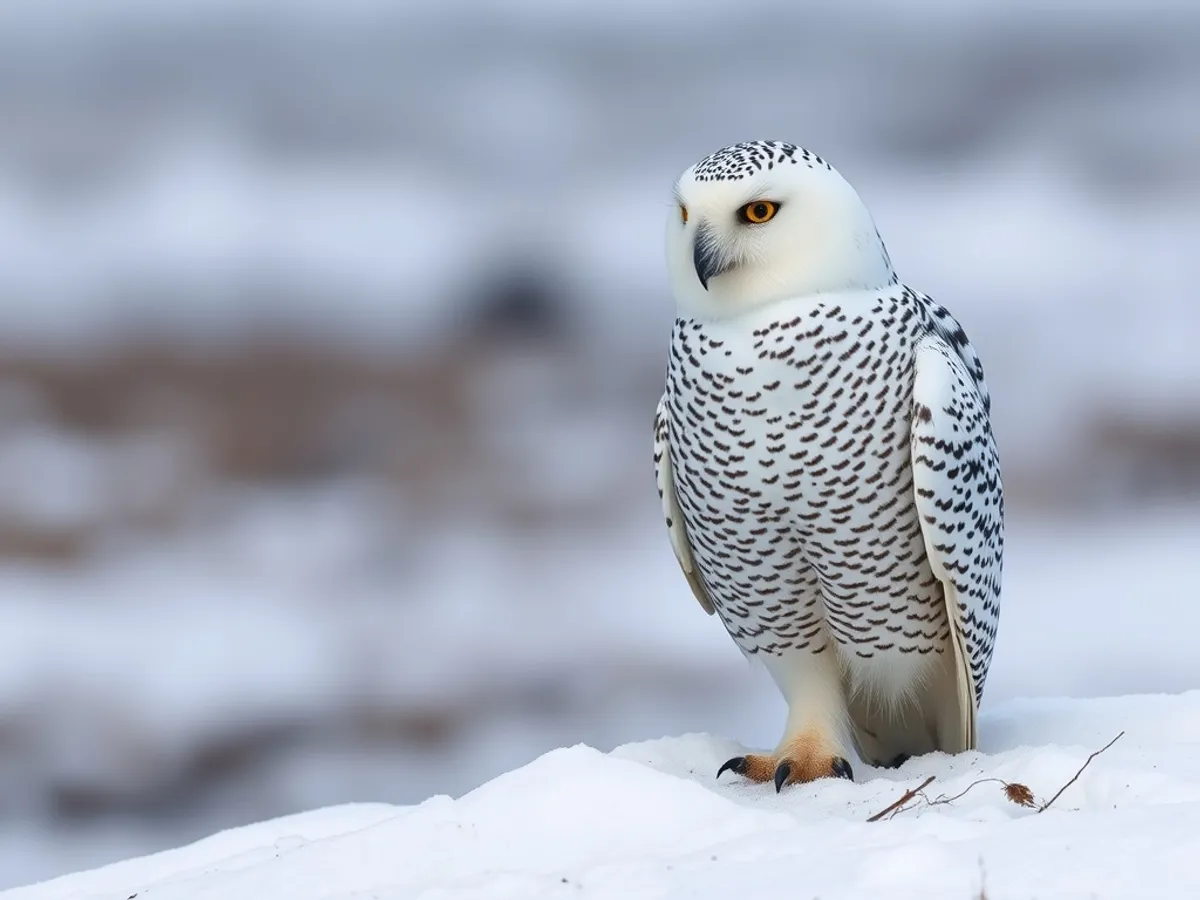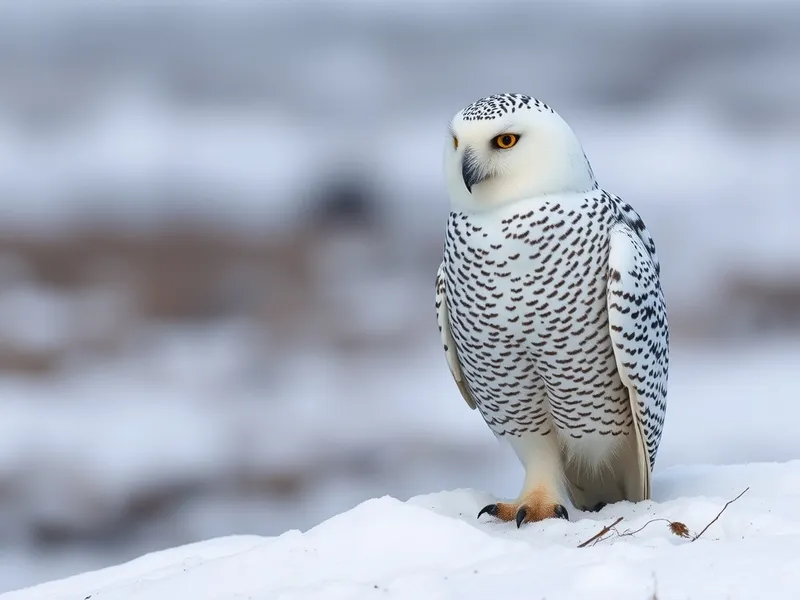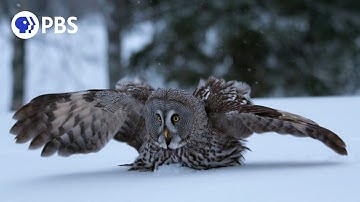
Snowy Owl
Bubo scandiacus

Meet the Snowy Owl
The Snowy Owl is a large, white owl native to the Arctic regions of North America and Eurasia. Its striking white plumage, often flecked with dark spots or bars, provides excellent camouflage in snowy environments. Snowy Owls are highly adapted for life in the tundra, with thick feathers covering even their legs and toes to insulate against extreme cold. They are nomadic, following lemming populations and other prey, and occasionally migrate far south in winter. These owls are diurnal, hunting both day and night during the long Arctic summer.
Classification
Bird
Habitat
Arctic tundra
Diet
Carnivore
Lifespan
9-10 years in the wild
Conservation
Vulnerable
Weight
1.6–3 kg
📖Fascinating Facts
Arctic Experts
Snowy Owls are perfectly adapted for surviving harsh Arctic conditions, with thick plumage covering even their feet to protect against freezing temperatures.
Daytime Hunters
Unlike most other owl species, Snowy Owls are often active during the day, taking advantage of the continuous daylight in their summer breeding grounds.
Lemming Specialists
Snowy Owls' breeding success is closely tied to lemming populations, and they may travel great distances in search of food when lemmings are scarce.
📋Detailed Description
The Snowy Owl (Bubo scandiacus) is a robust, large-bodied owl, with females typically larger than males, measuring 52–71 cm (20–28 in) in length and boasting a wingspan of 125–150 cm (49–59 in). Adult males are almost entirely white, while females and juveniles display variable dark barring and spots, especially on the wings and back, providing camouflage against the tundra landscape. Their dense plumage, including feathered legs and toes, is a critical adaptation for insulation against Arctic temperatures, sometimes reaching as low as -50°C. The head is round with yellow eyes and a black bill, often partially hidden by facial feathers. Snowy Owls possess acute vision and hearing, enabling them to detect prey even under snow cover. Unlike most owls, they are primarily diurnal, hunting during daylight hours, particularly during the continuous daylight of the Arctic summer. Their flight is strong and direct, with broad wings adapted for both long-distance travel and low, silent hunting flights. Snowy Owls are generally solitary outside the breeding season, but may be seen in loose aggregations where prey is abundant. Their vocalizations include a deep, booming hoot, primarily used by males during territorial displays and courtship.
💡 Did you know?
Unlike most owls, female and juvenile Snowy Owls have more extensive dark barring, while adult males can be almost pure white.
🔬Research & Sources
Wikipedia Summary
The snowy owl, also known as the polar owl, the white owl and the Arctic owl, is a large, white owl of the true owl family. Snowy owls are native to the Arctic regions of both North America and the Palearctic, breeding mostly on the tundra. It has a number of unique adaptations to its habitat and lifestyle, which are quite distinct from other extant owls. One of the largest species of owl, it is the only owl with mainly white plumage. Males tend to be a purer white overall while females tend to have more extensive flecks of dark brown. Juvenile male snowy owls have dark markings and may appear similar to females until maturity, at which point they typically turn whiter. The composition of brown markings about the wing, although not foolproof, is the most reliable technique for aging and sexing individual snowy owls.
Last Modified: 6/9/2025
🎭Behavior & Social Structure
Snowy Owls are opportunistic predators, with a diet dominated by small mammals, especially lemmings (Dicrostonyx and Lemmus spp.), which can constitute over 90% of their food intake during peak abundance. They also prey on other rodents, birds (including waterfowl and shorebirds), and occasionally fish or carrion. Hunting is typically conducted from a low perch or the ground, using a sit-and-wait strategy, followed by a swift, low flight to capture prey with their powerful talons. Snowy Owls exhibit nomadic and irruptive movements, traveling great distances in response to prey availability. During irruption years, they may appear far south of their typical range. Territorial during breeding, they defend large nesting areas, but outside the breeding season, territories are less defined. Social interactions are generally limited, though juveniles may form loose groups in winter. Their daily routine involves alternating periods of hunting and rest, with activity peaks during dawn and dusk in winter, and throughout the day in summer.
👶Reproduction & Life Cycle
Breeding occurs from May to September, timed with the peak abundance of lemmings. Snowy Owls are generally monogamous for the season, with pairs forming after elaborate courtship displays that include aerial acrobatics and food offerings by the male. Nests are simple scrapes on elevated tundra ridges or hummocks, providing visibility and drainage. Clutch size is highly variable (3–11 eggs), directly correlated with prey abundance; in lemming-rich years, larger clutches are common. Eggs are laid at 2-day intervals, and incubation, performed solely by the female, lasts 31–33 days. The male provides food during this period. Chicks are semi-altricial, hatching covered in white down, and are brooded by the female for the first 2–3 weeks. Both parents feed the young, which fledge at 5–6 weeks but may remain dependent for several weeks thereafter. Breeding success is closely tied to prey cycles, and in poor years, owls may forgo breeding altogether.
🛡️Adaptations & Survival
Snowy Owls are uniquely adapted to Arctic life. Their thick, layered plumage, including feathered feet, minimizes heat loss and allows survival in extreme cold. Their white coloration provides camouflage against snow, aiding both predator avoidance and hunting. Large, forward-facing eyes maximize light capture during low-light conditions, while asymmetrical ear placement enhances sound localization, crucial for detecting prey under snow. Their metabolism can adjust to periods of food scarcity, and their nomadic tendencies allow them to exploit fluctuating prey populations across vast distances. Snowy Owls also exhibit physiological adaptations for fasting and can store fat reserves during times of abundance.
🎨Cultural Significance
Snowy Owls hold a prominent place in the mythology and folklore of Arctic and sub-Arctic peoples, often symbolizing wisdom, endurance, and the spirit world. In Inuit culture, they are revered as messengers or guides, and their feathers and imagery appear in traditional art. In Western culture, the Snowy Owl gained widespread recognition through literature and media, notably as 'Hedwig' in the Harry Potter series. The species is also the official bird of Quebec, Canada. Historically, their striking plumage was sometimes used in ceremonial dress, though hunting is now rare and regulated.
🔬Recent Research & Discoveries
Recent research has focused on Snowy Owl migration using satellite telemetry, revealing unexpected long-distance movements, including trans-oceanic flights and irregular irruptions linked to prey dynamics. Studies have documented the effects of climate change on breeding phenology, nest success, and range shifts. Genetic analyses indicate low subspecies differentiation, suggesting high gene flow across the circumpolar range. Ongoing research is investigating the impact of contaminants (e.g., heavy metals, pesticides) in Arctic food webs and the potential for adaptation to rapidly changing environments. Citizen science initiatives, such as Project SNOWstorm, are providing valuable data on winter ecology and population trends.
🎥Wildlife Videos

Snowy Owl Magic: Nature's Silent and Mysterious Guardians | Full Documentary
The snowy owl glares across the tundra with all-knowing eyes – these owls seem to capture our imagination: but what lies beyond ...
Free High-Quality Documentaries

Snowy Owls | Why Is It The Most Skilled Arctic Predator? | Wildlife Documentary
Snowy owls live a life full of mystery up in the Arctic. Thousands of years ago, they built a community of fate with their neighbors ...
Best Documentary

Silent Snowy Owl Attack | Alaska's Deadliest
About National Geographic Wild: National Geographic Wild is a place for all things animals and for animal-lovers alike. Take a ...
Nat Geo Animals

How Snowy Owls Survive the Harsh Arctic Tundra | Nature Documentary
Enjoy a full 50-minute documentary about snowy owls "Snowy Owl – Queen of the North” Step into the Arctic wilderness to ...
Terra Mater

Snowy Owls Why Is It The Most Skilled Arctic Predator Wildlife Documentary
Snowy Owls Why Is It The Most Skilled Arctic Predator Wildlife Documentary.
BichosYmonstruitos

How Great Grey Owls Hunt Hidden Prey
The secret to the great grey owl's hunting success is its enormous facial disk. Please LIKE and SUBSCRIBE if you enjoyed it!
Nature on PBS
🌍Habitat Information
The Snowy Owl typically inhabits Arctic tundra environments. Snowy Owls have adapted to their environments with specialized features and behaviors.
Primary Habitat:
Arctic tundra
More detailed habitat information will be available soon.
🛡️Conservation Status
The Snowy Owl is currently classified as Vulnerable. Conservation efforts are crucial for preserving this species for future generations.
Common Threats:
- 🏠Habitat loss and fragmentation
- 🌡️Climate change impacts
- 🎯Hunting and poaching
- 🏭Human-wildlife conflict
⚠️Threats & Conservation Challenges
The primary threats to Snowy Owls include climate change, which alters tundra ecosystems and disrupts lemming population cycles, directly impacting breeding success. Habitat degradation from industrial development, oil and gas exploration, and increased human activity in the Arctic also pose risks. Collisions with vehicles, power lines, and wind turbines are significant sources of mortality, especially during irruption years when owls move south. Illegal shooting, trapping, and disturbance at nesting sites further threaten populations. The global population is estimated at 28,000 mature individuals (IUCN 2021), with a decreasing trend, leading to their current IUCN status as Vulnerable.
🔬Scientific Classification
Scientific Name
Bubo scandiacus
Classification Hierarchy
🔍 About Taxonomic Classification
Taxonomic classification is a hierarchical system used by scientists to classify and organize living organisms based on shared characteristics and evolutionary relationships.
The system moves from broad categories (Kingdom) to increasingly specific ones, with each animal's scientific name typically consisting of its Genus and species.
📝Community Notes
Share your observations and insights about the Snowy Owl with our community of wildlife enthusiasts.
Join Our Community
Sign in to share your observations and connect with fellow wildlife enthusiasts.
Sign In to ContributeNo community notes yet
Be the first to share your observations about the Snowy Owl!
Explore Snowy Owl
Select a tab above to learn more about this amazing animal.
📸Photo Gallery
No photos available for this animal yet.
🌟Discover More Wildlife
Continue your journey of discovery with more fascinating animals from our database
